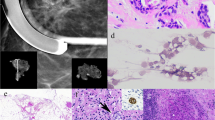Abstract
Background: Recent reports indicate that the sentinel node, defined as the first regional lymph node to receive lymphatic fluid from the breast, accurately represents the metastatic status of the primary breast cancer. However, routine single section examination of the regional nodes, including the sentinel node, underestimates the true incidence of metastases. The goal of this study is to determine whether multiple sectioning of sentinel nodes will detect occult metastases in operable breast cancer.
Methods: Nineteen patients with invasive breast cancers were injected with technetium-99m sulfur colloid solution around the tumor or at the biopsy site before lumpectomy and axillary lymph node dissection (ALND) or mastectomy. The labeled sentinel lymph nodes (SLND) were bivalved, and a central section was taken for hematoxylin and eosin (H & E) examination. The sentinel nodes of 13 patients, which were reported to be negative for metastases, were serially sectioned at 0.5-mm intervals and stained with H & E and a cytokeratin stain, CAM 5.2.
Results: In the 13 node-negative patients, occult metastases were found in the sentinel nodes of 3 patients (23%). Two were seen on H & E and one by cytokeratin stain. The mean numbers of SLND and ALND in this series were 2.6 and 12.5, respectively, and the average number of sections for the two groups was 14 and 1, respectively.
Conclusion: Multiple sectioning of the sentinel node or nodes detects occult metastases and changes the staging of breast cancer.
Similar content being viewed by others
References
Cady B, Stone MD, Wayne J. New therapeutic possibilities in primary invasive breast cancer.Ann Surg 1993;218:338–49.
Dowlatshahi K, Snider HC, Kim R. Axillary node status in non-palpable breast cancer.Ann Surg Oncol 1995;2:424–8.
Silverstein MJ, Gierson ED, Waisman JR, Senofsky GM, Colburn WJ, Gamagami P. Axillary lymph node dissection for T1a breast carcinoma.Cancer 1994;73:664–7.
Cady B. The need to reexamine axillary lymph node dissection in invasive breast cancer.Cancer 1994;73:505–8.
Saphir O, Amromin GD. Obscure axillary lymph node metastases in carcinoma of the breast.Cancer 1948;1:238–41.
Pickren JW. Significance of occult metastases. A study of breast cancer.Cancer 1961;14:1266–71.
Fischer ER, Swamidoss S, Lee CH, Rockette H, Redmond C, Fisher B. Detection and significance of occult axillary node metastases in patients with invasive breast cancer.Cancer 1978;42:2025–31.
International (Ludwig) Breast Cancer Study Group. Prognostic importance of occult axillary lymph node metastases from breast cancers.Lancet 1990;335:1565–8.
Krag DN, Weaver D, Alex JC, Fairbank JT. Surgical resection and radiolocalization of sentinel lymph node in breast cancer using a gamma probe.Surg Oncol 1993;2:335–9.
Giuliano AE, Dale P, Turner RR, Morton DL, Evans SW, Krasne DL. Improved axillary staging of breast cancer with sentinel lymphadenectomy.Ann Surg 1995;222:394–401.
Albertini JJ, Lyman GH, Cox C, et al. Lymphatic mapping and sentinel node biopsy in the patient with breast cancer.JAMA 1996;276:1818–22.
Giuliano AE, Jones RC, Brennan M, Statman R. Sentinel lymphadenectomy in breast cancer.J Clin Oncol 1997;15:2345–50.
Veronesi U, Paganelli G, Galimberti V, et al. Sentinel-node biopsy to avoid axillary dissection in breast cancer with clinically negative lymph-node.Lancet 1997;349:1864–67.
Dowlatshahi K, Fan M, Rayudu GV, Krag D, Sherkeirloo M, Bloom K. Diagnostic value of axillary sentinel node in operative breast cancer-work in progress.Breast Journal 1996;2:26.
Fisher B, Redmond C, Fisher ER. The contribution of recent NS-ABP clinical trials of primary breast cancer therapy to an understanding of tumor biology—an overview of the findings.Cancer 1980;46:1009–25.
Treatment alert issued for node-negative breast cancer.Monogr Natl Cancer Inst 1988;80:550–1.
Early Breast Cancer Trialists' Collaborative Group. Systemic treatment of early breast cancer by hormonal, cytotoxic or immune therapy: 133 randomized trials involving 31,000 recurrences and 24,000 deaths among 75,000 women.Lancet 1992;339(8785):1–15.
Early Breast Cancer Trialists' Collaborative Group. Systemic treatment of early breast cancer by hormonal, cytotoxic or immune therapy: 133 randomized trials involving 31,000 recurrences and 24,000 deaths among 75,000 women.Lancet 1992;339(8785):71–85.
Fisher B, Dignam J, Mamounas EP, et al. Sequential methotrexate and fluorouracil for the treatment of node-negative breast cancer in patients with estrogen receptor-negative tumors: Eight-year results from National Surgical Adjuvant Breast and Bowel Project (NSABP) B13 and first of findings from NSABP B-19 comparing methotrexate and fluorouracil with conventional cyclophosphamide, methotrexate and fluorouracil.J Clin Oncol 1996;14:1982–92.
Goldhirsch A, Castiglione M, Gelber RD. The International Breast Cancer Study Group. A single perioperative chemotherapy course for node-negative breast cancer: Five year results of trial V.Monogr Natl Cancer Inst 1992;11:89–96.
Ludwig Breast Cancer Study Group. Toxic effects of early adjuvant chemotherapy for breast cancer.Lancet 1983;2(8349):542–4.
Wells CA, Heryet A, Brochier J, Gatter KC, Mason DY. The immunohistochemical detection of axillary micrometastases in breast cancer.Br J Cancer 1984;50:193–7.
Bussolati G, Gugliotta P, Morra I, Pietribiasi F, Berardengo E. The immunohistochemical detection of lymph node metastases from infiltrating lobular carcinoma of the breast.Br J Cancer 1986;54:631–6.
Trojani M, de Mascarel I, Bonichon F, Coindre JM, Delsol G. Micrometastases to axillary lymph nodes from carcinoma of the breast.Br J Cancer 1987;55:303–6.
Morton DL, Wen DR, Wong JH, et al. Technical details of intraoperative lymphatic mapping for early stage melanoma.Arch Surg 1992;127:392–9.
Giuliano AE, Kirgan DM, Guenther JM, Morton DL. Lymphatic mapping and sentinel lymphadenectomy for breast cancer.Ann Surg 1994;220:391–401.
Author information
Authors and Affiliations
Rights and permissions
About this article
Cite this article
Jannink, I., Fan, M., Nagy, S. et al. Serial sectioning of sentinel nodes in patients with breast cancer: A pilot study. Annals of Surgical Oncology 5, 310–314 (1998). https://doi.org/10.1007/BF02303493
Received:
Accepted:
Issue Date:
DOI: https://doi.org/10.1007/BF02303493




